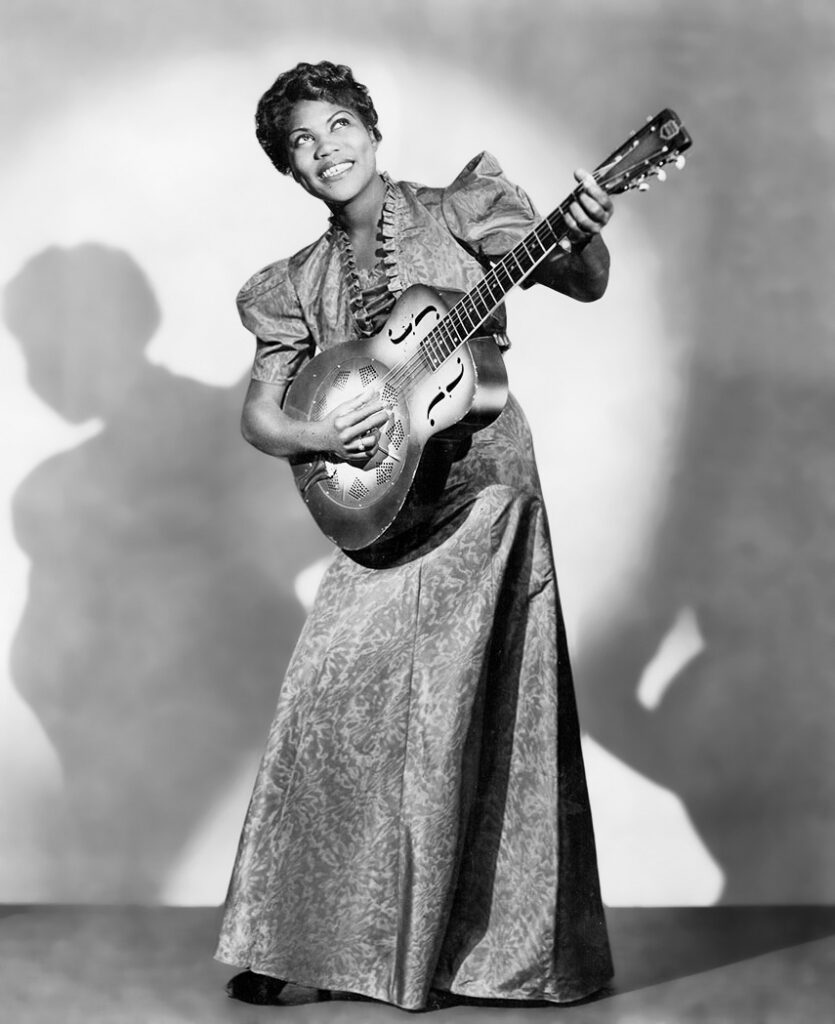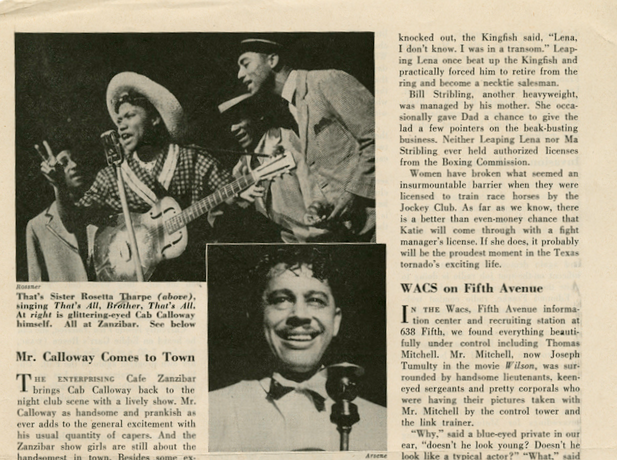WHM: “Godmother of Rock and Roll” Sister Rosetta Tharpe Turns 109

Photograph of Sister Rosetta Tharpe, taken by James J. Kriegsmann. Courtesy of user Blz 2049 of Wikimedia Commons.
By Daniel Winner | AC JosepH Media Correspondent
American singer, songwriter and guitarist Sister Rosetta Tharpe would have turned 109 years old this week on March 20. Posthumously known by fans as “the original soul sister” and “the Godmother of rock and roll,” she was a major musical influence in the music scene of the 1940s. Between her own pioneering technique of using heavy distortion on electric guitar and working between church and nightclub venues, Tharpe successfully bridged the gap between gospel and pop music, making way for several new innovations in the music industry.
Born Rosetta Nubin on March 20, 1915 in Cotton Plant, Arkansas, Tharpe was the daughter of Katie Bell Nubin and Willis Atkins, both cotton pickers. Both of her parents had a background as singers. Her mother was an active member of the local Church of God in Christ (COGIC), a Pentecostal denomination founded in 1897 by Black bishop Charles Harrison Mason. The founder was known for encouraging dancing, musical expression in worship, and allowing women to teach in church. At 6 years old, Tharpe took up her hobby of singing and playing guitar with her mother at the church under the stage name “Little Rosetta Nubin.”
In the early 1920s, Tharpe and her mother joined a traveling evangelical troupe, organizing gospel concerts and sermons throughout the South. After several years, the two settled down in Chicago, Illinois. As they continued to perform and travel around the country to church conventions, the young Tharpe acquired substantial attention from her music and became one among a very few nationally recognized Black female guitar players.
Tharpe married her first husband Thomas Thorpe in 1934, a COGIC preacher who would eventually join her and her mother on their musical tours. Although their marriage only lasted a few years, Thorpe served as an inspiration for the blossoming musician’s permanent stage name under an altered surname: “Sister Rosetta Tharpe.”
On Halloween, 1938, Tharpe recorded for the first time with Decca Records. This included instant hits such as “My Man and I,” “That’s All,” “The Lonesome Road” and “Rock Me,” the last setting the stage for Tharpe’s sway on the rock and roll industry.
Tharpe would go on to become one of the most renowned Black gospel singers in the country, and one of the first commercially successful gospel recording artists. Her notoriety skyrocketed in 1938 after appearing with Cab Calloway at Harlem’s Cotton Club as well as performing at Carnegie Hall for John Hammond’s “Spirituals to Swing” concert.
In the years that followed, Tharpe would perform alongside many other blues and jazz musicians at clubs and venues that were less than conservative. To some, this was a strange amalgamation of secular affairs and gospel music that could not be accepted in religious circles. Still others recognized her work as bridging the divide between the gospel scene and the nightlife culture that became so prominent in mid-20th century showbiz.

This was a time when women guitar players were few and far between, as the guitar was viewed as a masculine instrument. Patrons would compliment her skill on guitar, conceding to her ability to “play like a man.” Tharpe was also only one of two Black gospel artists to record V-discs for overseas troops during World War II, the other being the Golden Gate Quartet.
The newfound celebrity is even reported to have responded to the emerging rock scene, saying, “Oh, these kids and rock and roll — this is just sped up rhythm and blues. I’ve been doing that forever.” Ironically, several rock and roll musicians were profoundly impacted by Tharpe’s music, including such artists as Chuck Berry, Elvis Presley, Eric Clapton, Johnny Cash and Little Richard.
Despite her long-term success and cultural impact, Tharpe received little attention in the contemporary music world until she was honored by British folk punk-singer Frank Turner in the song “Sister Rosetta.” She was inducted into the Rock & Roll Hall of fame on May 5, 2018, nearly 45 years after her passing.
In 1970, Tharpe put a hiatus on her tour after she experienced a stroke, followed by the amputation of one of her legs due to complications from diabetes. On the eve of a scheduled recording Oct. 9, 1973, Rosetta Tharpe died in Philadelphia. She is buried in the city at Northwood Cemetery. Once a barren plot, her grave finally received a rose-colored memorial headstone on Jan. 11, 2009 which was partially funded by a benefit concert in Keswick Theatre in Glenside, PA.
The headstone reads:
ROSETTA ATKINS THARPE MORRISON
March 20, 1915
October 9, 1973
“Sister Rosetta”
Gospel Music Legend
SHE WOULD SING UNTIL YOU CRIED, AND THEN
SHE WOULD SING UNTIL YOU DANCED FOR JOY
SHE HELPED TO KEEP THE CHURCH ALIVE
AND THE SAINTS REJOICING
EDITOR’S NOTE: Daniel Winner has a double major in Religious Studies and Japanese from Penn State University and has traveled internationally to the Far East on several occasions. His insights on Buddhism and Asian culture give a unique view of historical and modern trends. He will be serving as a contributor for Front Runner New Jersey.
Follow Us Today On:
Note from AC JosepH Media: If you like this story and others posted on Front Runner New Jersey.com, lend us a hand so we can keep producing articles like these for New Jersey and the world to see. Click on SUPPORT FRNJ and make a contribution that will go directly in making more stories like this available. Thank you for reading!





